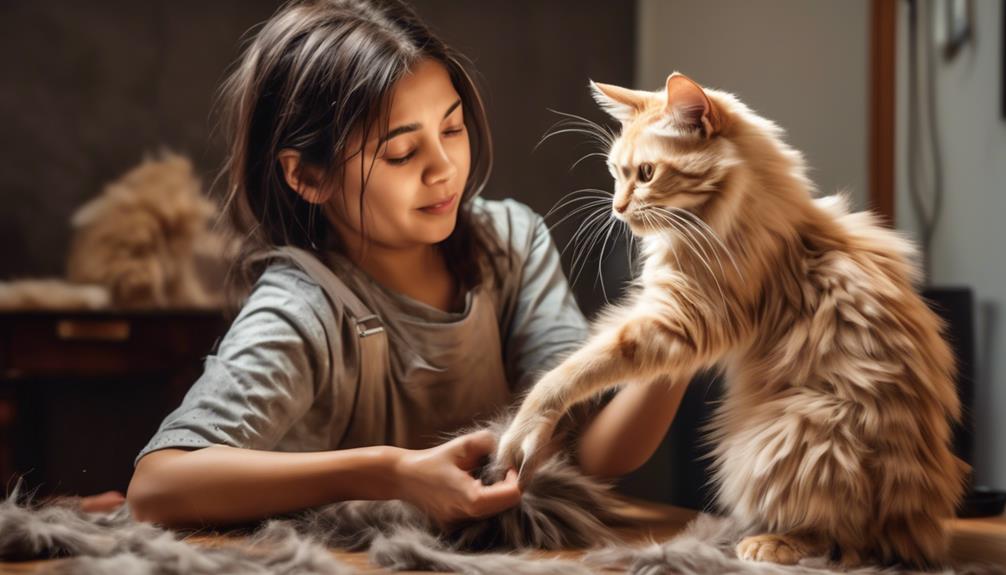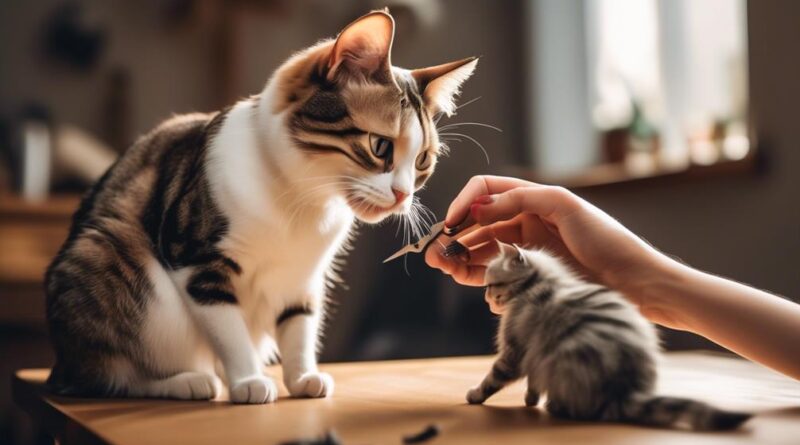What Are Typical Cat Grooming Blunders to Dodge?
You love your feline friend and want to keep them looking and feeling their best, but sometimes, the grooming process can end up causing more harm than good. From overlooked matting and tangles to improper bathing techniques, there are several common cat grooming blunders that can lead to discomfort and stress for your pet.
But fear not, by avoiding these missteps, you can ensure that your cat's grooming routine is a positive and beneficial experience for both of you.
Overlooking Matting and Tangles
Don't overlook matting and tangles in your cat's fur, as they can cause discomfort and skin irritation. Preventing matting is crucial for your cat's well-being. Regular grooming is key to preventing mats from forming. Brush your cat's fur at least a few times a week, especially if your feline friend has long hair. Use a comb or brush designed for cats to gently detangle any knots. Pay extra attention to areas prone to matting, such as behind the ears and under the arms.
Detangling methods are essential for keeping your cat's coat in top condition. If you notice a mat, resist the urge to pull or cut it out. This can be painful for your cat and may result in an uneven coat. Instead, use a specialized detangling spray or a small amount of conditioner to help loosen the mat. Gently work through the tangle with your fingers or a comb, starting from the outer edges and working your way in. For stubborn mats, consider seeking professional grooming assistance to ensure they're safely and effectively removed.
Using Incorrect Grooming Tools
To ensure you effectively prevent matting and tangles, it's important to use the correct grooming tools when caring for your cat's fur. Using incorrect tools can lead to discomfort for your cat and may even cause damage to their delicate skin and coat. Here's how to avoid this grooming blunder:
- Choosing suitable brushes: Different cat breeds have varying coat types, and thus, require specific types of brushes. For example, long-haired cats benefit from slicker brushes to prevent matting, while short-haired cats may require a softer bristle brush. It's essential to choose a brush that's suitable for your cat's fur length and texture to ensure effective grooming without causing any discomfort.
- Proper grooming techniques: Using the right tools is only half the battle. You also need to ensure that you're employing proper grooming techniques. Always brush in the direction of hair growth to prevent discomfort and potential skin irritation. Additionally, be gentle and patient, especially when dealing with tangles or mats. Rushing through the grooming process can lead to pulling and tugging, which can be painful for your cat.
- Regular maintenance: Regular grooming sessions help prevent matting and tangles. By incorporating a consistent grooming routine with the right tools and techniques, you can keep your cat's coat healthy and free from discomfort.
Neglecting Nail Trimming
Are you aware that neglecting nail trimming for your cat can lead to various health issues and discomfort? Proper nail health is essential for your cat's overall well-being.
Cats' nails can become overgrown, leading to ingrown nails, infections, and discomfort when walking or using the litter box. It's important to incorporate nail trimming into your cat's grooming routine to prevent these issues.
Regular nail trimming is essential for maintaining your cat's nail health. The frequency of nail trimming depends on your cat's lifestyle and activity level. Indoor cats may need more frequent nail trims as they don't wear down their nails as much as outdoor cats. On the other hand, outdoor cats may naturally wear down their nails through activities like climbing and scratching.
Generally, trimming your cat's nails every 1-2 weeks is a good starting point, but you may need to adjust this based on your cat's specific needs.
Neglecting nail trimming can result in your cat's nails becoming too long, which can cause them to curl into the paw pads, leading to pain and potential infections. Additionally, overgrown nails can affect your cat's gait and mobility, causing discomfort and potential joint issues over time.
Ignoring Dental Care
If you overlook dental care for your cat, you risk exposing them to potential oral health issues that can impact their overall well-being. Proper cat dental care is essential in preventing dental issues and maintaining good oral hygiene. Here are some key points to consider:
- Brushing Teeth: Just like humans, cats also require regular teeth brushing. Use a specialized toothbrush and toothpaste designed for cats. Start slowly, allowing your cat to get used to the process, and gradually increase the frequency. Brushing your cat's teeth can significantly reduce the risk of dental problems.
- Cat Dental Care: Regular visits to the veterinarian for dental check-ups are crucial. A professional can identify any dental issues early on and provide appropriate treatment. Additionally, your vet may recommend dental cleanings to remove tartar and plaque buildup, ensuring your cat's teeth and gums remain healthy.
- Preventing Dental Issues: Alongside brushing and professional care, provide your cat with dental treats and toys designed to promote dental health. These products can help reduce plaque and tartar, contributing to your cat's overall oral hygiene.
Skipping Ear Cleaning
Neglecting regular ear cleaning for your cat can lead to potential ear infections and discomfort. Proper ear hygiene is essential to prevent wax buildup, mites, and infections. Cats are meticulous groomers, but their ears often get overlooked. It's important to incorporate ear cleaning into your cat's grooming routine to prevent ear issues and ensure their overall well-being.
To maintain proper ear hygiene, you should regularly inspect your cat's ears for any signs of dirt, wax, or redness. Use a veterinarian-recommended cat ear cleaning solution and cotton balls to gently wipe the outer ear. Be cautious not to insert anything into the ear canal as this can cause damage. By including ear cleaning in your grooming regimen, you can significantly reduce the likelihood of your cat developing painful ear infections.
Preventing ear infections is crucial for your cat's comfort and health. A proactive approach to ear cleaning can help avoid the discomfort and distress associated with ear problems. Neglecting this aspect of grooming can result in unnecessary pain for your feline friend. Therefore, taking the time to clean your cat's ears regularly is a simple yet effective way to prioritize their well-being.
Improper Bathing Techniques
To ensure your cat's comfort and cleanliness, it's crucial to master proper bathing techniques. Cats are known for their aversion to water, so it's important to approach bathing with care and patience. Here are some key tips to help you avoid common bathing blunders and ensure a successful grooming session:
- Avoiding water: Start by introducing your cat to water gradually. Fill the tub or sink with a small amount of warm water before gently placing your cat in it. Use a handheld sprayer or a cup to wet your cat's fur, avoiding the face and ears. Choose a cat-friendly shampoo and lather it gently, taking care to rinse thoroughly to prevent skin irritation. Avoid getting water in your cat's ears to prevent discomfort and potential ear infections.
- Proper drying techniques: After the bath, wrap your cat in a towel and gently pat to absorb excess water. Avoid vigorous rubbing, as this can cause additional stress for your feline friend. Use a hairdryer on the lowest setting or allow your cat to air dry in a warm, draft-free area. If using a hairdryer, maintain a safe distance and constantly move the dryer to prevent overheating and discomfort.
Rushing Through the Grooming Process

Take your time and avoid rushing through the grooming process to ensure your cat's comfort and safety. Proper brushing techniques are essential for maintaining your cat's coat and skin health. Rushing through brushing can lead to discomfort for your cat and may result in skin irritation or even injury. Set aside dedicated time for grooming to create a calm and stress-free environment for your cat.
When grooming your cat, it's crucial to establish a routine that allows for an adequate amount of time for each grooming session. Rushing through the process can cause your cat to become anxious and may lead to behavioral issues during grooming. By taking your time and approaching the grooming process with patience, you can help your cat feel more relaxed and cooperative.
Proper brushing techniques, such as using gentle strokes and paying attention to any tangles or mats, require time and attention to detail. Rushing through brushing can lead to missing knots or causing unnecessary discomfort for your cat. By allocating sufficient time for grooming, you can ensure that each grooming session is thorough and effective.
Disregarding Skin and Coat Health
Brushing your cat's coat regularly and paying attention to their skin health is crucial for their overall well-being. Neglecting their skin and coat health can lead to various issues such as dry skin, matting, and even more serious conditions. Here are some common mistakes to avoid when it comes to your cat's skin and coat health:
- Skipping Regular Brushing: Regular brushing is essential for maintaining a healthy coat and skin. It helps to remove loose fur, distribute natural oils, and prevent matting. Neglecting this grooming routine can lead to tangles, mats, and skin irritation.
- Not Providing Proper Diet: A proper diet is crucial for your cat's skin and coat health. Ensure that your cat's diet includes essential nutrients such as omega-3 and omega-6 fatty acids, which are vital for skin health. In some cases, skin and coat supplements may be recommended by your veterinarian to support your cat's overall skin and coat health.
- Ignoring Signs of Skin Issues: It's important to closely monitor your cat's skin for any signs of irritation, redness, flakiness, or hair loss. Ignoring these signs can lead to more severe skin problems. If you notice any abnormalities, consult your veterinarian to address the issue promptly.
Frequently Asked Questions
How Often Should I Groom My Cat?
You should groom your cat regularly to avoid tangles and matting. By brushing your cat a few times a week, you can help prevent hairballs and keep their coat healthy. Use gentle grooming techniques to make it a positive experience.
What Are Some Signs That My Cat May Be Experiencing Discomfort During Grooming?
If your cat shows signs of discomfort during grooming, like hissing or swatting, it may indicate pain. Monitor for behavioral changes, and consider adjusting grooming frequency to make the experience more comfortable for your feline friend.
Are There Any Specific Grooming Techniques for Long-Haired Vs. Short-Haired Cats?
For long-haired cats, shedding management and mat prevention are crucial. Regular brushing with appropriate grooming tools helps with tangle removal. Short-haired cats also benefit from shedding management to minimize loose hair around your home.
Can I Use Human Grooming Products on My Cat?
You should avoid using human grooming products on your cat. Proper cat grooming involves using products specifically designed for felines. Human products can be harmful and cause skin irritation or allergic reactions in cats.
What Should I Do if My Cat Becomes Aggressive During Grooming?
If your cat becomes aggressive during grooming, consider alternative methods like using calming treats, pheromone sprays, or seeking professional help. Avoid forcing grooming and find solutions that keep both you and your cat safe.
Conclusion
So, remember to avoid these typical cat grooming blunders to keep your feline friend looking and feeling their best.
Take the time to properly groom your cat, using the correct tools and techniques to prevent matting, tangles, and other issues.
By paying attention to their skin, coat, nails, teeth, and ears, you can ensure that your cat stays happy, healthy, and well-groomed.
